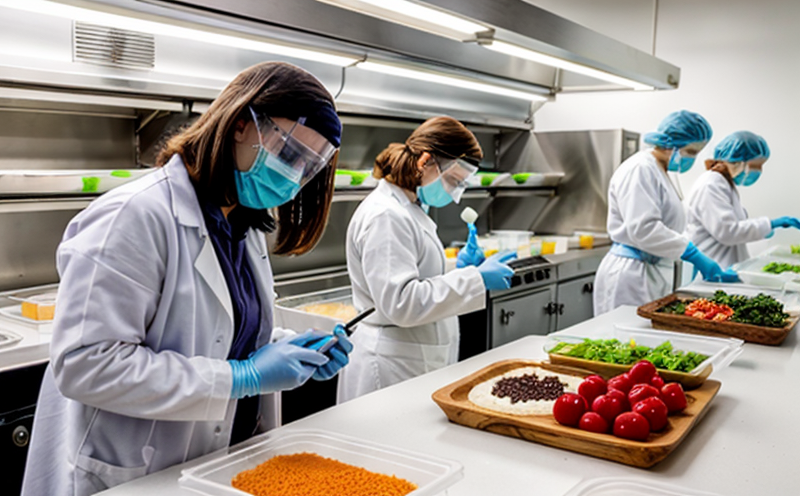ISO 4832 Coliform Bacteria Testing in Food
The ISO 4832 standard is pivotal in the food microbiology sector, providing a robust framework for detecting coliform bacteria. Coliforms are indicator organisms that suggest the potential presence of pathogenic microorganisms in food products. This testing method is essential for ensuring food safety and quality, especially in sectors like dairy, meat processing, and ready-to-eat meals.
The methodology outlined in ISO 4832 involves a series of steps designed to identify coliforms through the use of selective media that favor their growth while suppressing other microorganisms. The process starts with proper sampling of food products, which should be representative of the batch being tested. Sampling techniques vary depending on the product type—such as liquid samples for beverages or solid samples for processed foods.
Once collected, specimens undergo rigorous preparation to ensure accurate results. This can include homogenization and dilution processes to prevent overgrowth during incubation. After preparation, the samples are inoculated onto selective media such as m-cycloserine cefixime tetracycline agar (mCCCT), which allows for the rapid differentiation of coliforms from other bacteria.
The incubation period is critical; it typically ranges from 24 to 48 hours at specific temperatures, depending on the media used and the type of coliform being detected. During this time, characteristic colonies indicative of coliforms will appear under microscopic examination. The presence of these colonies provides a quantitative measure of coliform contamination within the food sample.
The significance of ISO 4832 lies in its role as an international standard that ensures consistency and reliability across different laboratories worldwide. This uniformity is crucial for maintaining high standards of food safety, particularly when exporting products to countries that adhere to this standard.
Compliance with ISO 4832 also supports broader industry goals related to sustainability by minimizing the risk of contaminated products reaching consumers. By identifying potential issues early in the production cycle, companies can implement corrective actions promptly, thereby reducing waste and improving overall efficiency.
This testing method plays a vital role in quality control processes, helping manufacturers maintain consistent product standards. It is particularly useful for detecting contaminants that could compromise food safety, such as E. coli O157:H7 or Salmonella spp., which may not be directly detected by coliforms but indicate possible contamination.
Understanding the nuances of ISO 4832 requires familiarity with its procedural details and the importance of accurate interpretation of results. For instance, a positive test result for coliforms should prompt further investigation into the source of potential contamination to prevent larger-scale issues down the line.
In conclusion, adherence to ISO 4832 is not just about meeting regulatory requirements; it's an integral part of ensuring that food products meet stringent quality and safety standards. By leveraging this standardized approach, businesses can enhance consumer confidence while contributing positively to environmental sustainability efforts.
Applied Standards
| Standard Number | Description |
|---|---|
| ISO 4832:2019 | Microbiology of food and feed - Horizontal method for the enumeration of coliform bacteria in foods. |
The ISO 4832 standard establishes a comprehensive framework for detecting coliform bacteria, which is crucial for ensuring food safety. This particular methodology focuses on providing a horizontal approach to enumerating these bacteria across various types of food products. The standard specifies detailed procedures for sample preparation, inoculation onto selective media, and incubation conditions.
Understanding the nuances of this standard helps laboratories and quality assurance teams interpret results accurately and consistently. By following the guidelines set forth in ISO 4832, organizations can ensure that their testing processes are aligned with international best practices, thereby enhancing reliability and trustworthiness of food safety assessments.
Benefits
- Enhanced Food Safety: Identifying coliform bacteria early helps prevent the spread of harmful pathogens.
- Improved Quality Control: Consistent adherence to ISO 4832 ensures product quality remains at optimal levels.
- Avoidance of Legal Penalties: Compliance with international standards minimizes risks associated with non-compliance.
- Increased Consumer Confidence: Transparent testing processes build trust among consumers regarding product safety.
The benefits extend beyond mere compliance; they encompass broader impacts on public health, business operations, and environmental sustainability. By minimizing the risk of contaminated products reaching consumers, companies can foster long-term relationships with customers while contributing positively to global food security initiatives.
Environmental and Sustainability Contributions
The application of ISO 4832 in food microbiology testing contributes significantly to environmental sustainability by ensuring that only safe and uncontaminated products reach the market. This reduces waste associated with recalled or discarded goods due to contamination, thus conserving resources and reducing carbon footprints.
Furthermore, by implementing robust quality control measures based on international standards like ISO 4832, businesses contribute positively to sustainable development goals. These efforts align with broader global initiatives aimed at improving food safety and promoting responsible consumption practices.
The use of selective media in coliform bacteria testing also supports eco-friendly practices by enabling precise identification without unnecessary overuse of resources. By focusing solely on relevant indicators, laboratories can optimize their operational efficiency while maintaining high standards of environmental responsibility.





